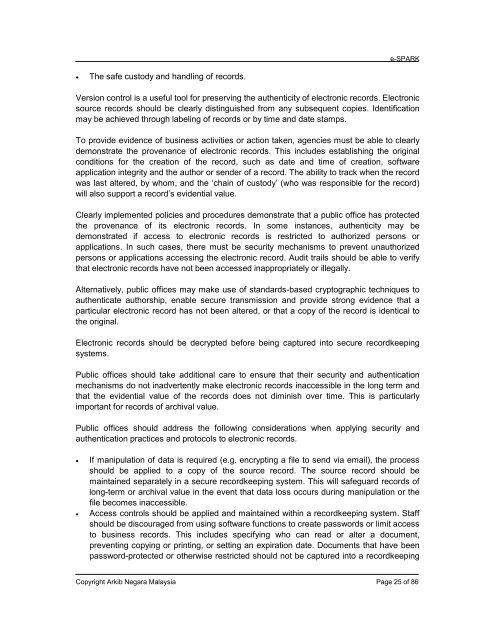Arkib Negara ELECTRONIC RECORDS MANAGEMENT and archive mgmt guideline_eng
Create successful ePaper yourself
Turn your PDF publications into a flip-book with our unique Google optimized e-Paper software.
e-SPARK<br />
• The safe custody <strong>and</strong> h<strong>and</strong>ling of records.<br />
Version control is a useful tool for preserving the authenticity of electronic records. Electronic<br />
source records should be clearly distinguished from any subsequent copies. Identification<br />
may be achieved through labeling of records or by time <strong>and</strong> date stamps.<br />
To provide evidence of business activities or action taken, agencies must be able to clearly<br />
demonstrate the provenance of electronic records. This includes establishing the original<br />
conditions for the creation of the record, such as date <strong>and</strong> time of creation, software<br />
application integrity <strong>and</strong> the author or sender of a record. The ability to track when the record<br />
was last altered, by whom, <strong>and</strong> the ‘chain of custody’ (who was responsible for the record)<br />
will also support a record’s evidential value.<br />
Clearly implemented policies <strong>and</strong> procedures demonstrate that a public office has protected<br />
the provenance of its electronic records. In some instances, authenticity may be<br />
demonstrated if access to electronic records is restricted to authorized persons or<br />
applications. In such cases, there must be security mechanisms to prevent unauthorized<br />
persons or applications accessing the electronic record. Audit trails should be able to verify<br />
that electronic records have not been accessed inappropriately or illegally.<br />
Alternatively, public offices may make use of st<strong>and</strong>ards-based cryptographic techniques to<br />
authenticate authorship, enable secure transmission <strong>and</strong> provide strong evidence that a<br />
particular electronic record has not been altered, or that a copy of the record is identical to<br />
the original.<br />
Electronic records should be decrypted before being captured into secure recordkeeping<br />
systems.<br />
Public offices should take additional care to ensure that their security <strong>and</strong> authentication<br />
mechanisms do not inadvertently make electronic records inaccessible in the long term <strong>and</strong><br />
that the evidential value of the records does not diminish over time. This is particularly<br />
important for records of archival value.<br />
Public offices should address the following considerations when applying security <strong>and</strong><br />
authentication practices <strong>and</strong> protocols to electronic records.<br />
• If manipulation of data is required (e.g. encrypting a file to send via email), the process<br />
should be applied to a copy of the source record. The source record should be<br />
maintained separately in a secure recordkeeping system. This will safeguard records of<br />
long-term or archival value in the event that data loss occurs during manipulation or the<br />
file becomes inaccessible.<br />
• Access controls should be applied <strong>and</strong> maintained within a recordkeeping system. Staff<br />
should be discouraged from using software functions to create passwords or limit access<br />
to business records. This includes specifying who can read or alter a document,<br />
preventing copying or printing, or setting an expiration date. Documents that have been<br />
password-protected or otherwise restricted should not be captured into a recordkeeping<br />
Copyright <strong>Arkib</strong> <strong>Negara</strong> Malaysia Page 25 of 86


